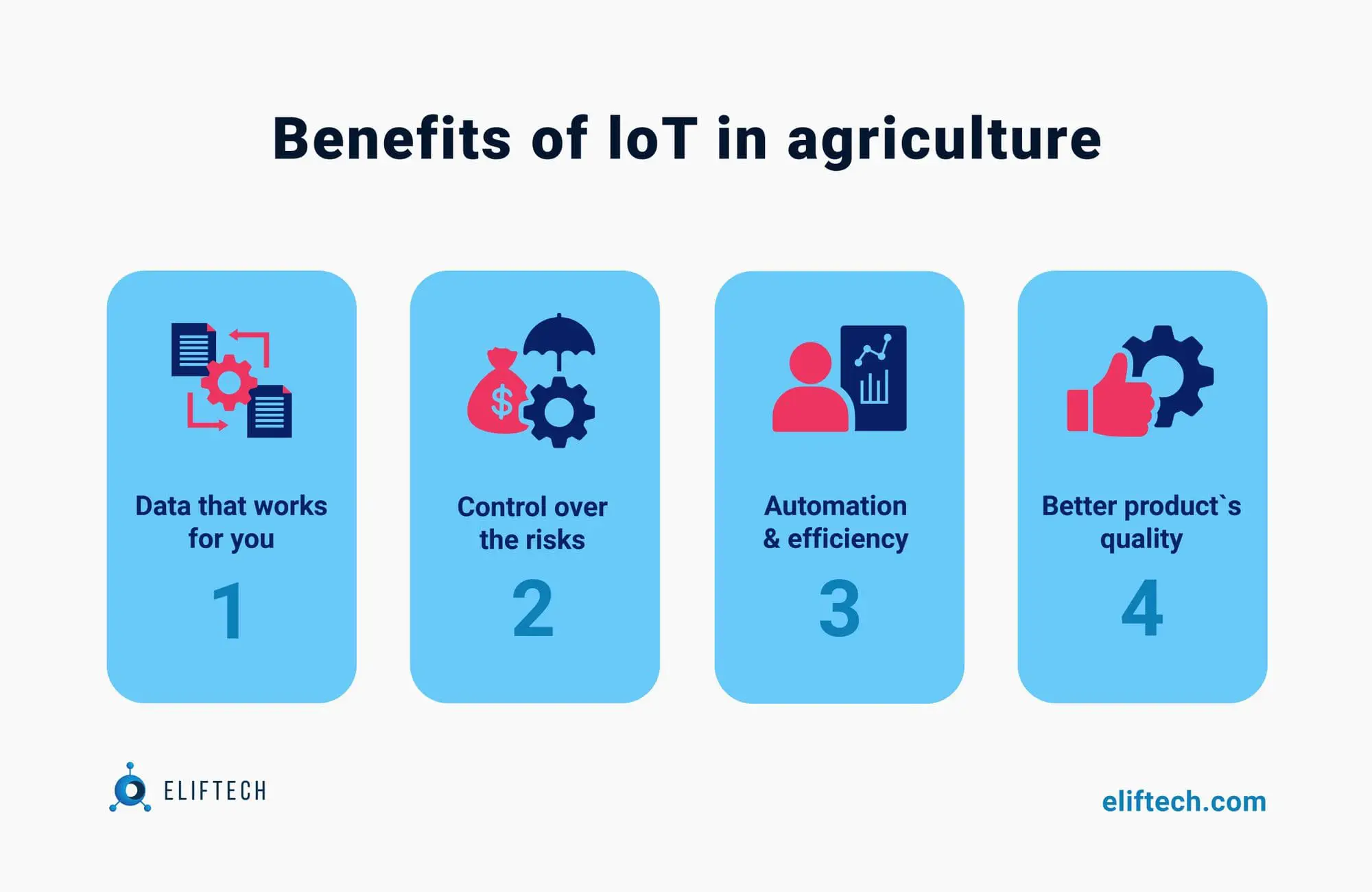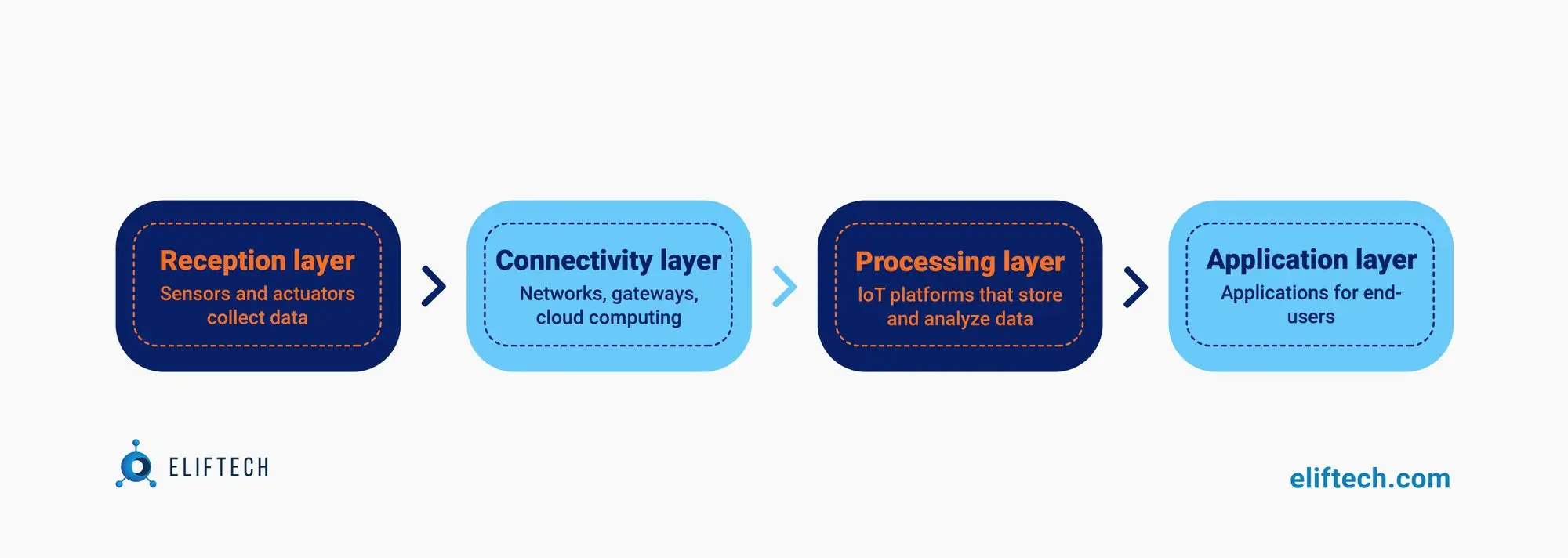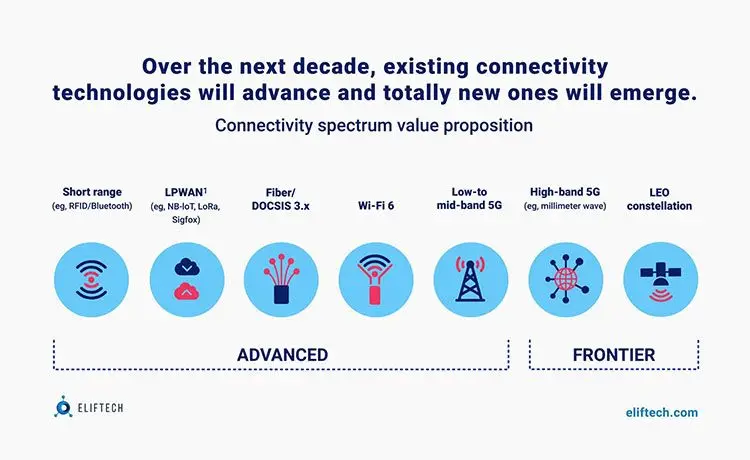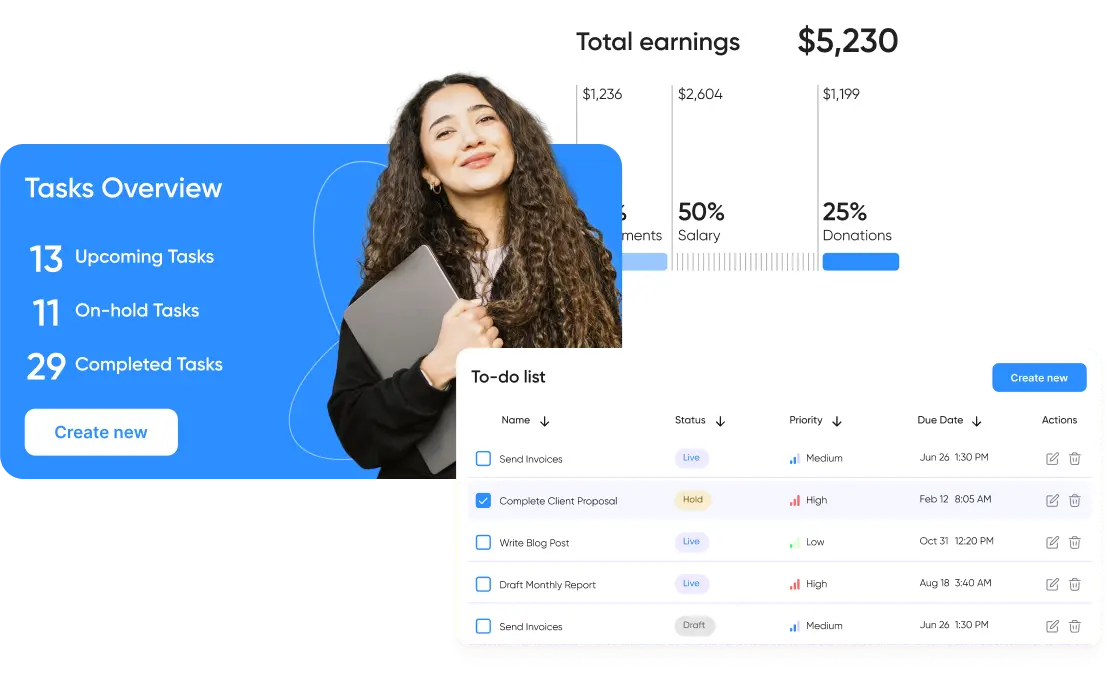IoT
What is Connected Agriculture?
How IoT translates to connected agriculture and connected farming? What are the current forecast and challenges of connected agriculture and precise farming?
Agriculture is one of the oldest types of human activity, and at the same time, it is an excellent ground for introducing the latest technological developments. Yes, they are already talking about the Second Green Revolution: investment company Goldman Sachs predicts that to improve the productivity of globally connected agriculture, the market size will increase by 70% by 2050. This forecast is partly based on the active development of the Internet of Things and connected objects within the connected agriculture technology tech landscape amounting to "smart" connected farming activities. So, how does IoT work in agriculture, and how does it develop the connected agriculture industry with the help of the Internet of Things?
IoT solutions in modern farming: What is Connected Agriculture?
The Internet of Things, in simple words, is a network of devices connected to the Internet. IoT networks are often built on machine-to-machine interaction technology: devices connect to the telecommunications network and exchange real-time data automatically.
In addition, there are IoT platforms for managing "smart" connected devices and platforms for managing M2M SIM cards in such instruments. The device or SIM card communicates with the control center responsible for data storage and analysis. The system, relying on the analysis results, performs a given action under certain parameters. For example, the sensor detects excessive dryness of the soil conditions - the "smart" water and irrigation management system is turned on.
Thanks to the scalability of IoT platforms, the technology can be utilized both by small private farm operators and huge agricultural corporations. This is how connected farming appeared when communication and information technologies were connected to agriculture: drones monitor herds, plants are planted after soil analysis, and an artificial microclimate is maintained in greenhouses.

The benefits of IoT in agriculture:
- Controls agricultural management in production planning;
- Reduces the risks to crop cultivation and crop management in production planning and helps prevent product loss;
- Collects information and analyzes huge amounts of data;
- Monitors the general state of the economy and the efficiency of processes;
- Reduces costs;
- Reduces the amount of waste;
- Offers livestock management that monitors the animal health and the condition of plants;
- Reduces the share of manual labor;
- Raises product quality standards.
How to apply IoT technologies in agriculture?
- Connected agriculture: During precision farming, the system analyzes the soil's condition and determines which crop will yield the highest on a specific plot. Fields are also "overgrown" with technology: connected sensors for monitoring the general state of plants, temperature, and moisture level.
- Automation of greenhouses: The Internet of Things in agriculture makes it possible to create a suitable microclimate for "capricious" crops in greenhouses: control irrigation, lighting, air humidity, and temperature.
- "Smart" irrigation systems: For rational water consumption, sensors installed on the entire field record the dryness and looseness of the soil. As soon as the system detects deviations from the norm, automatic irrigation will start. This connected agriculture solution prevents both dryness and excessive watering.
- Livestock advanced farming solutions (including livestock tracking): Sensors are attached to each animal. Devices can monitor the condition of each animal and the entire herd, which is sometimes referred to as "animal welfare." They also track the location and movement of the pack.
- Organization of meteorological stations: One of the most common practices today is devices located in the field to collect data on weather conditions, which are used to preserve and increase the harvest.
- Monitoring of farm equipment and transport: The system is used for many tasks: taking into account the working time of drivers, optimizing fuel consumption, tracking routes, controlling the location on the field, and monitoring the condition of the agricultural equipment.
- Drones: Sometimes, a tractor or combine harvester does not even need a driver; a drone does the work. Drones also help determine the density of sowing the field.
- Management of raw materials: The correct sorting, storage, and processing of raw materials with the help of IoT in agriculture reduces costs and minimizes personnel work.
Four phases of connected agriculture
In recent decades, agriculture has undergone major transformations, becoming more industrialized and technology-oriented. By using various connected farming gadgets, farmers have gained access to advanced farming solutions, thus, better control over breeding livestock and growing crops, making these processes more predictable and increasing efficiency. This data is generally used to track the health of your business in general, as well as staff productivity, agricultural equipment efficiency, and more.
- Improved control over internal processes and, as a result, reduction of production risks. The ability to predict production volumes allows you to plan a more efficient distribution of products. Knowing how much you will harvest, you can be sure your product will not go unsold.
- Costs management and reduced waste through increased production control. By seeing any abnormalities in crop growth or livestock health, you can reduce the risk of crop loss.
- Increasing business efficiency with the help of process automation. Several production cycle processes can be automated using intelligent devices, such as irrigation, fertilization, or pest control.
- Improving yields by raising the quality and volume of products. Gain more comprehensive control methods for the production process. Moreover, yield monitoring allows for maintaining higher crop quality standards and growth ability through automation.

Data collection
Data collection is the beginning of precision agriculture and, therefore, the most researched stage. This mainly takes place through the determination of soil fertility (one sample from the field, a polygon, or a zone). Zones are designated with the help of aerial or satellite imaging and formed based on yield maps or overlaying images of the same crop over several years. It is done to increase yields eventually. The most common method of soil testing is a one-hectare polygon grid. This grid dimension is sufficient to understand the field's variability and what is happening in it. Then, based on the obtained soil scan, task maps are formed for specific applications of fertilizers and liming.
One method of assessing soil quality is probing with sensor equipment that can determine soil electrical conductivity, pH, organic matter, temperature, moisture, transpiration, and soil structure. This information will be used to make decisions about specific agronomic techniques. There is a very interesting device for reading information from the soil. It is attached to the seeder and calculates the sowing rate. This device is currently being tested to change the seeding rate in real time based on the data read from the soil. In addition, some sensors are placed directly on the plant. They read whether the plant has enough nutrients and moisture and what stresses and diseases it is experiencing, and based on this information, decisions can be made about fertilizing, applying certain pesticides, etc.
All information obtained from the field and soil has value and adds to the value of the land. Fields with clear data, like maps and field history, can be worth more than those without such information.
Analysis of collected information
Analyzing the information collected from the fields is a new approach to precision agriculture that has arisen due to a large amount of data. Therefore, it is important to correctly diagnose, verify and interpret the information to make effective planning and management decisions. “Ag leader technology” are digital tools that collect, store, interpret information, model, and provide solid grounds for making the right decisions. All information is included in large databases obtained from all possible sources. The more accurate the data, the more useful it can be.
All aspects of agriculture production can provide data. For example, by collecting information on agricultural equipment or employees' work, you can calculate their productivity (efficiency) and find ways to optimize it. In the future, we will measure everything possible and analyze large databases with the help of artificial intelligence and neural networks. The Agro-IT platform is a comprehensive online service for system management of agribusiness and complete automation of accounting and management, covering all areas of the enterprise's activities.
Usually, the system is built according to the All-in-One principle with modular separation. It automatically combines data from various sources for further analysis, data processing, and risk management. Conventionally, all agriculture platforms can be divided into modules, which are subsequently separated into the following areas:
- Land bank management and field mapping;
- Post-production planning and production task planning, determination of production technologies;
- Monitoring and analysis of completed works in real-time (telematics);
- Field monitoring;
- Production economics: cost accounting, warehouse stock accounting, purchases;
- Automatic recording of operations and automation of document flow;
- Logistics;
- Sale and realization of products;
- Agriculture platforms.
How does agriculture implement the IoT?
The population is projected to reach 9.6 billion by 2050, creating a major challenge for agriculture. The demand for more food must be met despite extreme weather conditions, increasing climate change, and environmental impacts. To meet these growing needs, agriculture must turn to new technologies. New smart agriculture applications based on IoT technologies will enable the agriculture industry to reduce waste and increase productivity, from optimizing fertilizers to improving agrarian machine routes' efficiency. This is the application of modern ICT (information and communication technologies) in agriculture.
An intelligent farm based on IoT has built a system for monitoring fields using sensors (light, humidity, temperature, soil moisture, etc.) and automation of the irrigation system. These tools assist farmers and make monitoring field conditions accessible from anywhere. As a result, IoT-based connected farming is more efficient than the conventional approach. The application of IoT-based smart agriculture is suitable not only for conventional, large-scale agriculture operations. It can become a new leverage to boost other industry trends, such as organic farming and family farming (complex or small spaces, particularly cattle or niche crops because it allows preserving individual or high-quality varieties, etc.) and improve highly transparent agriculture.
Regarding environmental issues, IoT-based connected farming can bring great benefits, including inventory management optimization, more efficient water use, and improved input and data processing. Now let's talk about the main areas of application of IoT-based intelligent agriculture, which revolutionized the industry.
1. Monitoring of climatic conditions: The most likely gadgets for smart farming are weather stations that combine a complex of climate conditions sensors. Located in the field, the sensors collect different data from the environment and send it straight to the cloud.
2. Automation of greenhouses: IoT sensors allow you to receive accurate real-time information about the microclimate in the greenhouse, lighting, temperature, soil condition, and humidity. In addition to receiving environmental data, weather stations can adjust conditions according to preset parameters. In particular, greenhouse automation systems use a similar principle.
3. Crop management: Like weather stations, the sensors are generally placed in the field to collect crop-specific data, from temperature and rainfall to leaf water potential and overall crop condition. As a result, you can monitor crop growth and abnormalities to effectively prevent disease or infestation that may harm your crop.
4. Livestock monitoring and management: As in the case of crop monitoring, agriculture IoT sensors can be connected to farms for animal tracking, monitoring health, and recording performance. Similarly, animal tracking and monitoring help farmers collect data on animals' health parameters, down to blood pressure and precise physical location. For instance, a sensor can identify sick animals so that the farmers can separate them from the herd to prevent infection from spreading.
5. Precision farming: Precision farming is about efficiency and data-driven decisions. It is one of the most common and effective applications of IoT in agriculture. Using IoT sensors, farmers can collect a wide range of metrics on every aspect of the field's microclimate and ecosystem: light, temperature, soil condition, moisture, CO2 levels, and pest infestation. This data allows farmers to estimate the optimal amount of water, fertilizer, and pesticides their crops require, thus reducing costs and growing better quality and healthier crops.
6. Agriculture drones: One of the most promising achievements in agriculture technology is using drones in intelligent agriculture. Also known as unmanned aerial vehicles, drones are better equipped to collect agrarian data than airplanes and satellites.
7. Statistical analytics for smart farming: Precision farming and predictive analytics go hand in hand. While IoT technology and smart sensors are a goldmine for highly relevant real-time data, data analytics helps farmers make sense of it and predict harvest time, disease and infection risks, yield volume, and more. In addition, data analytics tools help make agriculture, which is inherently weather dependent, more manageable and predictable.
8. Complex farm management systems: A more sophisticated approach to IoT products in agriculture may be the so-called farm productivity management segment systems. They typically imply agriculture IoT devices and sensors installed on the property and a powerful dashboard with analytical capabilities and built-in accounting/reporting functions. This enables remote sensing and remote farm monitoring and optimizes most business operations. In addition to the listed uses of IoT in agriculture, some important opportunities include vehicle tracking or automation, storage management, logistics, etc.
Challenges that prevent the adoption of IoT in connected agriculture
The aggressive expansion of the land bank and the desire to squeeze everything out of this land to the last drop leads to its degradation, a decrease in productivity, and the accumulation of debts. And all this is against the backdrop of irreversible climate change. So agribusiness is turning into an arms race with emerging technologies, artificial intelligence, the Internet of Things, constantly expanding knowledge, and the search for new approaches to increase efficiency.
Generations of connected agriculture solutions in Ag leader technology are changing extremely rapidly. Quite recently, differential application of fertilizers looked like this: soil tests were taken and sent to the laboratory, then the differential application maps for field equipment were created, recorded on a flash drive, etc. Already last year, soil samples could be taken and analyzed simply in the field using a portable device. Nowadays, even such a need has disappeared! The fastest and easiest solution is sensors that analyze the condition of the soil and its need for elements. Installed on the pole of the agriculture machinery (with a step of 6 m), these sensors give a command to the controller to apply a certain amount of a specific element.
Imagine you need to know how deep the tractor plowed the field. Previously, this value was calculated mathematically, considering the speed of movement, engine revolutions, etc. Nowadays, it is enough to install an ultrasonic sensor to have absolute control over the quality of tillage. Agriculture technologies are advancing by leaps and bounds to the total dominance of artificial intelligence in decision-making. As a result, the number of data sources is increasing - from various sensors, weather stations, drones, and satellite images, as well as data on chemical analysis of soils, moisture content of the grain, and weight of each grain batch.
One of the stages on this path in the agriculture sector is the introduction of digital projects: the exchange of data from sensors installed on combines, tractors, scales, and moisture meters. Partially or completely, the agriculture sector did start to introduce the latest technologies. Let's talk about the most interesting cases.
What prevents farmers from starting working with innovations the most?
- Lack of time to study all innovations and compare software functionality. Without a clear understanding, it is impossible to make a good choice.
- Uncertainty: is it necessary at all? Even though the whole world is going digital…
- Innovation generations change very quickly. Who will implement this "new" in the economy? And this list of questions is endless.
As a result, a farmer uses a digital solution, which is often not comprehensive, or is a set of unrelated and not integrated data solutions. Therefore, it is necessary to help farmers implement the best global innovative developments and offer a complete integrated system and complex implementation and support services. The innovations should be accessible to any agriculture enterprise, regardless of its land bank size.
Even small farms that rent out combines and grain trucks and connect to the software to monitor harvest online. In this case, each farmer will receive a personal access password and see only their holdings in the software. However, software and professional monitoring cost several dollars per hectare a year, which does not compare to the average statistical losses due to stolen crops, fuel, seeds, and other valuables.
Problems in the field of agriculture that IoT can solve
The Food and Agriculture Organization (FAO) has published data on the calculation of food losses. According to them, custom software development in the post-harvest stage on the way to retailers worldwide helps reduce waste. Moreover, on a global scale, it is almost impossible to identify critical loss points at the current moment if not monitored with IoT. IoT in agriculture differs from region to region. Asia-Pacific agriculture market insight can highlight key technological developments in agriculture that enable micro-farmers to use technologies that transform the future of agriculture.
FAO also lists farmers' main challenges, such as depleting water supplies. 30% is the world's average estimate of food losses. The Asia Pacific region has developed IoT approaches that actively work with climate change and global warming aftereffects on agriculture and livestock farming. The Internet of Things is growing exponentially, but IoT projects in agricultural and livestock farming landscapes remain an "abstinent" niche for many organizations. Integrated IoT systems also may include cloud computing and big data solutions, as most Industrial IoT does. But agricultural and farming IoT systems provide many specific benefits as they manage several things simultaneously.
First, an integrated approach can increase the climate resilience of farms. So the farming grounds and assets may become less impacted by extreme weather events, which usually harm natural resources. Second, sustainable agriculture, which becomes a reality with an integrated approach, reduces soil erosion and improves productivity while providing additional socioeconomic benefits. Finally, integrated strategies to resist climate change in agriculture can increase food and beverage companies production numbers while still addressing the broader sustainability issues. For example, in developing countries, like Latin America, there are groups of goods for which farmers' losses are quite large. In some rural areas, it can match the Indicators of larger entities, like North America. Thus, establishing an effective policy to reduce food loss and waste in rural areas requires comprehensive information about where, when, and at what point in the value chain food is wasted.
Other obstacles and challenges of Connected Agriculture
- Difficulties in connected agriculture marketing to small and medium-sized producers;
- Wrong choice of harvesting dates;
- Transportation of agricultural products;
- Loss and damage to up to 30% of farm products during transportation due to:
- Non-compliance with the conditions of the vehicle (temperature, humidity, gas contamination, shaking, etc.);
- Violations of the duration of transportation;
- Poor quality packaging and stocking;
- Reloading of transport and fuel drains;
- Violations of logistics processes in case of deviation from the delivery schedule and routes;
5. There are still some issues with connected agriculture solutions for storage;
6. Loss and deterioration of up to 10% of agriculture products during storage due to:
- Non-compliance with storage conditions (temperature, humidity, ventilation, illumination, etc.);
- Storage violations;
- Mechanical damage during loading/unloading of products;
7. Demand volatility;
8. Lack of demand from large retailers for agriculture products with changed quality.
How to succeed at building connected farming software projects?
The control and automation of the processes included in the cycle have helped to significantly reduce the costs that arise when food is lost or wasted. The project's goal is to use connected sensors and data analysis to reduce the index of food losses, although the accompanying tasks were also indirectly solved.
How to successfully build Smart Farming? This is an ecosystem with 4 categories of users: farmers, carriers, warehouses, and shops. Depending on the category, the user has access to certain ecosystem features. The key idea is that each participant understands their area of responsibility and how violations will affect the final cost of products in the store. In addition, the system allows for fully automated control of parameters during the transportation to the warehouse and storage.
Connected agriculture solutions for farmers
A farmer can track the current demand for various product groups and see historical demand data from past periods. This allows for solving one of the main problems of variability in demand for certain groups of food products. If the farmer does not have contractual relations for the sale of products, they can use the built-in mechanisms of the electronic exchange of agriculture products by adding their product to the public pool of the trade and setting the price.
In the case of successful marketing of products based on previously formed contractual relations with a warehouse, retailer, or sales through an electronic trade exchange, the farmer gets access to track the transportation and storage conditions of the products. Violation notifications are automatically configured depending on the product category. Upon such notice, sanctions may be applied to the violator.
Connected agriculture solutions for carriers
Special connected sensors are attached to the body of the truck and telematics equipment is installed in the vehicle itself to measure and transmit various parameters during transportation to the cloud platform:
- The temperature inside and outside the body;
- Humidity inside and outside the body;
- Shaking, sudden braking, and acceleration during transport;
- Volatile organic compounds;
- Axle load, etc.
One of the equipment modifications allows you to install an actuator responsible for cooling or heating the body. Along with the order, the carrier automatically receives the regimes necessary to comply with the correct conditions of carriage. Likewise, the machine automatically sets and maintains the parameters during transport if it has an actuator. Possible overload is controlled when transferring products to the carrier, and deviation from the route will be detected during the trip. Also, the route can have control points, which fix the time intervals of transportation in different sections and estimate the total deviation. If conditions are violated during transport, the farmer and warehouse are notified and can decide on sanctions for the carrier. In addition, the warehouse employee can adjust the modes and terms of storage of products based on the actual transportation conditions.
Barriers and weight control devices are installed on the territory of the storage facility, to which the driver must be given access both in automatic mode (when crossing the geo-fence) and in a manual way (via a chatbot) - opening the barrier and turning on the weight control. When unloading products, the warehouse employee evaluates the products' quality, considering whether the transportation conditions were violated. Thus, the processes become transparent, and a reliable rating of farmers and carriers is formed.
Connected agriculture solutions for storage
The warehouse is equipped with special telematics equipment that measures the parameters and transfers them to the cloud platform during the storage of products:
- Temperature;
- Humidity;
- Illumination
- Volatile organic compounds;
- Weight;
- Air exchange rate.
The storage may also have actuators that control the air exchange and/or the cooling system. The processes for controlling the storage of goods are generally similar to the operations during transportation, with only slightly different templates for automatic regulation and notification. All data on storage conditions are also available for each product on the electronic trading exchange. And depending on the storage conditions and violation of the requirements, the storage rating is formed.
Due to creating a hardware and software complex, it was possible to unite all participants within one ecosystem. As a result, most business processes have become more transparent, and the parties' responsibility has increased significantly. In addition, the functionality of the complex made it possible to provide tools that create connected agriculture market dynamics and easy access for small producers to large retailers. Consequently, encouraging efficient cooperation increase the number of participants (clients) and, thus – overall connected agriculture market growth.
What is the future of Connected Agriculture?
Today's global population growth requires the development of technologies to make agriculture processes more efficient to keep up with growing demand. The combination of IoT, AI, machine learning, and mobile technology can play a decisive role in this process.
The value of data increases when it is used to optimize processes and interact or create new business models. All interactions with farmers and farming processes in agribusiness are increasingly based on data. These data will be used for future decisions of agronomists and experts. Artificial intelligence and machine learning help farmers receive the right information at the right time.
The principle of artificial intelligence is one where a machine can perceive its environment and take action to solve a certain goal related to that environment. One of the premises of machine learning is that this machine (using a series of algorithms) can improve its ability to solve problems and objectives related to the environment and thereby better "predict" a range of outcomes. The more input and statistical information are collected, the better the algorithm will predict various outcomes.
The simplest example is "precision farming" with unmanned tractors, computer vision advanced technologies for advanced farming solutions, devices that recognize weeds among healthy plants, etc. The greatest value of AI and machine learning is not just to give the farmer accurate details but to immediately accompany the information with advice on what decisions to make, for example, how to apply chemicals correctly. That is, the technology does not replace but continues the experience of professional agronomists and helps them make decisions.
Technological future of agriculture: A new agrarian revolution
Integrating the received data with various intelligent IT applications that process them in real-time is a revolutionary approach to decision-making for the farmer. It provides the latter with the results of analyzing multiple factors and justification for further actions. For example, based on scientific calculations, the system can create recommendations for treating and caring after plants or instructions for the automatic execution of tasks by robotic machinery.

The Internet, the development of artificial intelligence, and machine learning are the components of one truly revolutionary process of digitization and automation of agriculture. The intensive use of these technologies in agriculture promises to transform an industry less affected by IT into a high-tech business due to explosive productivity and cost reduction growth. Agriculture 4.0 is not even the future but the current reality.
Digital innovation is blurring the borderlines between the physical and digital worlds. So, the digital economy means going beyond the simple presence and availability of data and using data, with the help of artificial intelligence, to extract meaningful additional agriculture information and make more truthful predictive models. Based on this information, agriculture producers increase farming productivity and make more effective planning and management decisions.
Digital data is the "glue" that unites the elements of the ecosystem to improve the efficiency of all processes. Autonomous agriculture consulting services is about to become a new norm. Automated equipment will work better than with an operator, as the human intervention factor is eliminated. A larger area under cultivation now requires to be automated and more efficient machinery. Our experts foresee that in the future, all tractors will be fully autonomous, and farmers will be able to track every seed. The world of sensors will explode, and data, if adequate, will become a commodity.
Want to learn to use digital transformation to develop data solutions for your agricultural or farming efforts? Contact our consulting services team.
FAQ
Browse our case studies and get actionable insights to drive your success
See more
